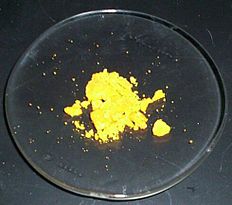Iron(III) chloride
Iron(III) chloride, also known as ferric chloride, is a compound of iron and chlorine with the formula FeCl3. It is a moderately strong Lewis acid and many of its applications exploit this property. It normally exists as a hexahydrate salt. When heated or anhydrous, it tends to hydrolyze, producing hydrogen chloride gas. It is a popular catalyst for organic synthesis, and the most common printed circuit board etchant (though there are better ones).
Contents
Properties
Physical properties
Iron(III) chloride is a yellow solid as the common hexahydrate form, but undergoes many different color changes when the anhydrous form is viewed under different light sources at different angles. Aqueous solutions tend to be dark brown in color. The material resembles aluminum chloride due to its covalent character, and has a narrow liquid range when anhydrous, ranging from only 306 to 315 °C, and dimerizes as a vapor.
Chemical properties
As a strong Lewis acid, iron(III) chloride is corrosive and readily forms adducts with Lewis bases, such as triphenylphosphine oxide. It will also dissolve in methanol and ethanol quite readily. It is also highly soluble in acetone. Strong heating will convert the hexahydrate form, or the anhydrous form in the presence of water, to iron(III) oxychloride and hydrogen chloride, and the anhydrous form to iron(II) chloride and chlorine gas. It is a mild oxidizing agent. It is capable of reacting with copper yielding copper chloride and ferrous chloride.
Iron(III) chloride hydrates cannot be dehydrated to anhydrous, because it decomposes to iron(III) oxychloride and hydrogen chloride, or iron hydroxide and hydrogen chloride.
When solutions of iron(III) chloride are presented with metallic iron, they are slowly reduced back to iron(II) chloride, which can be reverted back to iron(III) chloride by the addition of more hydrochloric acid and oxygen or hydrogen peroxide.
Availability
Iron(III) chloride is a popular printed circuit board (PCB) etchant. It is available as a solution at many electronics store, such as RadioShack.
Preparation
Iron (III) chloride hydrate may be produced by adding steel wool (which is relatively pure iron) to a mixture of hydrogen peroxide and hydrochloric acid, and then filtering off the carbon. Anhydrous iron (III) chloride can be produced by combining pure iron metal to dry chlorine gas at high temperature.
Solutions of green iron(II) chloride slowly oxidize in air or on heating to form iron(III) chloride, provided there are excess chloride ions in solution. This is a somewhat reversible reaction, as the addition of more iron to ferric chloride solutions reverts it back to iron(II) chloride.
Projects
- Detecting phenol compounds
- Etching widmanstätten patterns into meteorites
- Making iron complexes
- Producing ferrocene
- Producing ferrofluid[1]
Handling
Safety
Iron(III) chloride is corrosive and will stain many surfaces dark brown.
Storage
Ferric chloride should be stored in closed plastic or glass bottles, at a low pH.
Disposal
Ferric chloride can be neutralized with calcium hydroxide.
